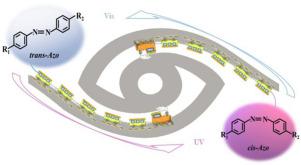当前位置:
X-MOL 学术
›
Chin. J. Anal. Chem.
›
论文详情
Our official English website, www.x-mol.net, welcomes your
feedback! (Note: you will need to create a separate account there.)
Applications of Photo-Responsive Molecules in Nanopore-based Devices
Chinese Journal of Analytical Chemistry ( IF 1.2 ) Pub Date : 2020-11-01 , DOI: 10.1016/s1872-2040(20)60058-5 Jing TANG , Sen WANG , Ji WU , Li-Yuan LIANG , Liang WANG , De-Qiang WANG
Chinese Journal of Analytical Chemistry ( IF 1.2 ) Pub Date : 2020-11-01 , DOI: 10.1016/s1872-2040(20)60058-5 Jing TANG , Sen WANG , Ji WU , Li-Yuan LIANG , Liang WANG , De-Qiang WANG

|
Abstract In biochemistry, it is crucial to explore the conformation, response to external environment and interaction rules of biomacromolecules and small molecules for understanding the correlation of the structures and properties among organic matters. However, it is a challenge for the traditional techniques to observe the conformation heterogeneity and interpret the interaction mechanism of the biomolecules in living cells. As the emerged the third generation single-molecule gene sequencing technology, nanopore is used to monitor the conformation change of the molecules in situ and therefore demonstrate good applications in single-molecule sensing and nucleic acid and protein sequencing. To further improve the detection resolution and precision, the combined photoelectric detection that can achieve higher accuracy via introducing optical-responsive molecules is adopted. In view of the extensive applications and development status of nanopore technique in single-molecule conformation resolution, this paper summarizes the research progress of the nanopore devices and the design and applications of some typical photo-responsive molecules in nanopore sensing, including azobenzenes and their derivatives (Azos), spiropyrane (SP) and diarylethene (DAE). Light regulation is a simple and effective approach for the monitoring of the molecular structures, and the further integration with nanopore devices exhibits great potential in single-molecule detection meanwhile sheds light on the design and applications of multi-responsive nano-devices.
中文翻译:

光响应分子在纳米孔器件中的应用
摘要 在生物化学中,探索生物大分子和小分子的构象、对外界环境的反应以及相互作用的规律,对于理解有机物之间结构和性质的相关性至关重要。然而,传统技术观察构象异质性并解释活细胞中生物分子的相互作用机制是一个挑战。作为第三代单分子基因测序技术的出现,纳米孔用于原位监测分子的构象变化,因此在单分子传感和核酸和蛋白质测序方面具有良好的应用。为了进一步提高检测分辨率和精度,采用组合光电检测,通过引入光响应分子可以获得更高的精度。针对纳米孔技术在单分子构象解析中的广泛应用和发展现状,本文总结了纳米孔器件的研究进展以及一些典型的光响应分子在纳米孔传感中的设计与应用,包括偶氮苯及其衍生物。 (Azos)、螺吡喃 (SP) 和二芳基乙烯 (DAE)。光调控是分子结构监测的一种简单有效的方法,与纳米孔器件的进一步集成在单分子检测方面具有巨大潜力,同时为多响应纳米器件的设计和应用提供了启示。针对纳米孔技术在单分子构象解析中的广泛应用和发展现状,本文总结了纳米孔器件的研究进展以及一些典型的光响应分子在纳米孔传感中的设计与应用,包括偶氮苯及其衍生物。 (Azos)、螺吡喃 (SP) 和二芳基乙烯 (DAE)。光调控是一种简单有效的分子结构监测方法,与纳米孔器件的进一步集成在单分子检测方面具有巨大潜力,同时为多响应纳米器件的设计和应用提供了启示。针对纳米孔技术在单分子构象解析中的广泛应用和发展现状,本文总结了纳米孔器件的研究进展以及一些典型的光响应分子在纳米孔传感中的设计与应用,包括偶氮苯及其衍生物。 (Azos)、螺吡喃 (SP) 和二芳基乙烯 (DAE)。光调控是分子结构监测的一种简单有效的方法,与纳米孔器件的进一步集成在单分子检测方面具有巨大潜力,同时为多响应纳米器件的设计和应用提供了启示。本文综述了纳米孔器件的研究进展以及一些典型的光响应分子在纳米孔传感中的设计和应用,包括偶氮苯及其衍生物(Azos)、螺吡喃(SP)和二芳基乙烯(DAE)。光调控是一种简单有效的分子结构监测方法,与纳米孔器件的进一步集成在单分子检测方面具有巨大潜力,同时为多响应纳米器件的设计和应用提供了启示。本文综述了纳米孔器件的研究进展以及一些典型的光响应分子在纳米孔传感中的设计和应用,包括偶氮苯及其衍生物(Azos)、螺吡喃(SP)和二芳基乙烯(DAE)。光调控是一种简单有效的分子结构监测方法,与纳米孔器件的进一步集成在单分子检测方面具有巨大潜力,同时为多响应纳米器件的设计和应用提供了启示。
更新日期:2020-11-01
中文翻译:

光响应分子在纳米孔器件中的应用
摘要 在生物化学中,探索生物大分子和小分子的构象、对外界环境的反应以及相互作用的规律,对于理解有机物之间结构和性质的相关性至关重要。然而,传统技术观察构象异质性并解释活细胞中生物分子的相互作用机制是一个挑战。作为第三代单分子基因测序技术的出现,纳米孔用于原位监测分子的构象变化,因此在单分子传感和核酸和蛋白质测序方面具有良好的应用。为了进一步提高检测分辨率和精度,采用组合光电检测,通过引入光响应分子可以获得更高的精度。针对纳米孔技术在单分子构象解析中的广泛应用和发展现状,本文总结了纳米孔器件的研究进展以及一些典型的光响应分子在纳米孔传感中的设计与应用,包括偶氮苯及其衍生物。 (Azos)、螺吡喃 (SP) 和二芳基乙烯 (DAE)。光调控是分子结构监测的一种简单有效的方法,与纳米孔器件的进一步集成在单分子检测方面具有巨大潜力,同时为多响应纳米器件的设计和应用提供了启示。针对纳米孔技术在单分子构象解析中的广泛应用和发展现状,本文总结了纳米孔器件的研究进展以及一些典型的光响应分子在纳米孔传感中的设计与应用,包括偶氮苯及其衍生物。 (Azos)、螺吡喃 (SP) 和二芳基乙烯 (DAE)。光调控是一种简单有效的分子结构监测方法,与纳米孔器件的进一步集成在单分子检测方面具有巨大潜力,同时为多响应纳米器件的设计和应用提供了启示。针对纳米孔技术在单分子构象解析中的广泛应用和发展现状,本文总结了纳米孔器件的研究进展以及一些典型的光响应分子在纳米孔传感中的设计与应用,包括偶氮苯及其衍生物。 (Azos)、螺吡喃 (SP) 和二芳基乙烯 (DAE)。光调控是分子结构监测的一种简单有效的方法,与纳米孔器件的进一步集成在单分子检测方面具有巨大潜力,同时为多响应纳米器件的设计和应用提供了启示。本文综述了纳米孔器件的研究进展以及一些典型的光响应分子在纳米孔传感中的设计和应用,包括偶氮苯及其衍生物(Azos)、螺吡喃(SP)和二芳基乙烯(DAE)。光调控是一种简单有效的分子结构监测方法,与纳米孔器件的进一步集成在单分子检测方面具有巨大潜力,同时为多响应纳米器件的设计和应用提供了启示。本文综述了纳米孔器件的研究进展以及一些典型的光响应分子在纳米孔传感中的设计和应用,包括偶氮苯及其衍生物(Azos)、螺吡喃(SP)和二芳基乙烯(DAE)。光调控是一种简单有效的分子结构监测方法,与纳米孔器件的进一步集成在单分子检测方面具有巨大潜力,同时为多响应纳米器件的设计和应用提供了启示。











































 京公网安备 11010802027423号
京公网安备 11010802027423号